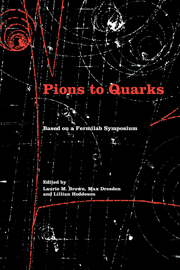Book contents
- Frontmatter
- Contents
- List of contributors
- Foreword by Leon M. Lederman
- Editors' acknowledgments
- Photographs of the symposium
- List of abbreviations
- List of notation
- I Introduction
- II Particle discoveries in cosmic rays
- III High-energy nuclear physics
- IV The new laboratory
- V The strange particles
- VI Weak interactions
- VII Weak interactions and parity nonconservation
- VIII The particle physics community
- IX Theories of hadrons
- 39 The early S-matrix theory and its propagation (1942–1952)
- 40 From field theory to phenomenology: the history of dispersion relations
- 41 Particles as S-matrix poles: hadron democracy
- 42 The general theory of quantized fields in the 1950s
- 43 The classification and structure of hadrons
- 44 Gauge principle, vector-meson dominance, and spontaneous symmetry breaking
- X Personal overviews
- Name index
- Subject index
43 - The classification and structure of hadrons
Published online by Cambridge University Press: 07 May 2010
- Frontmatter
- Contents
- List of contributors
- Foreword by Leon M. Lederman
- Editors' acknowledgments
- Photographs of the symposium
- List of abbreviations
- List of notation
- I Introduction
- II Particle discoveries in cosmic rays
- III High-energy nuclear physics
- IV The new laboratory
- V The strange particles
- VI Weak interactions
- VII Weak interactions and parity nonconservation
- VIII The particle physics community
- IX Theories of hadrons
- 39 The early S-matrix theory and its propagation (1942–1952)
- 40 From field theory to phenomenology: the history of dispersion relations
- 41 Particles as S-matrix poles: hadron democracy
- 42 The general theory of quantized fields in the 1950s
- 43 The classification and structure of hadrons
- 44 Gauge principle, vector-meson dominance, and spontaneous symmetry breaking
- X Personal overviews
- Name index
- Subject index
Summary
I give a sketch here of the discovery of SU(3) symmetry and quarks. I first review three failed attempts to use dynamical models directly; these were replaced by the quark model, once the SU(3) pattern was identified in the phenomenological hadron spectrum. I then analyze the factors that led to SU(3) and discuss the related roles of classification in mathematics and in physics. I describe the emergence of the quark model and conclude with a discussion of the present form of the “flavor” and generations problem.
The structural or dynamical attempts
There are no real prescriptions in the construction of science, since it is truly an exploration of the unknown, rather than an engineering feat. Some years ago, I realized that the entire endeavor of scientific research precisely fulfills the role of the randomized mechanism necessary in any evolutionary machinery. Since the advent of “man the toolmaker,” evolution has become the evolution of human society, rather than the Darwinian evolution of genetic features of man the primate (although the two may soon merge again, with the development of genetic engineering). Society “mutates” through technological innovation, and the random process characteristic of any mutationary mechanism is, in this case, scientific research. “Good” mutations, such as the invention of flint tools or of computers, survive and turn the evolutionary wheel.
It is thus presumptuous of me to try to systematize the scientific method, and yet some broad lines may be drawn, with the qualification that things often work out differently.
- Type
- Chapter
- Information
- Pions to QuarksParticle Physics in the 1950s, pp. 630 - 638Publisher: Cambridge University PressPrint publication year: 1989



